It’s Summer Reading season, and while the books I’m sharing today wouldn’t fit into the traditional category of “summer reading,” they are helping to get this next season of reading off to a (mostly) strong start. Let’s get to the reviews!
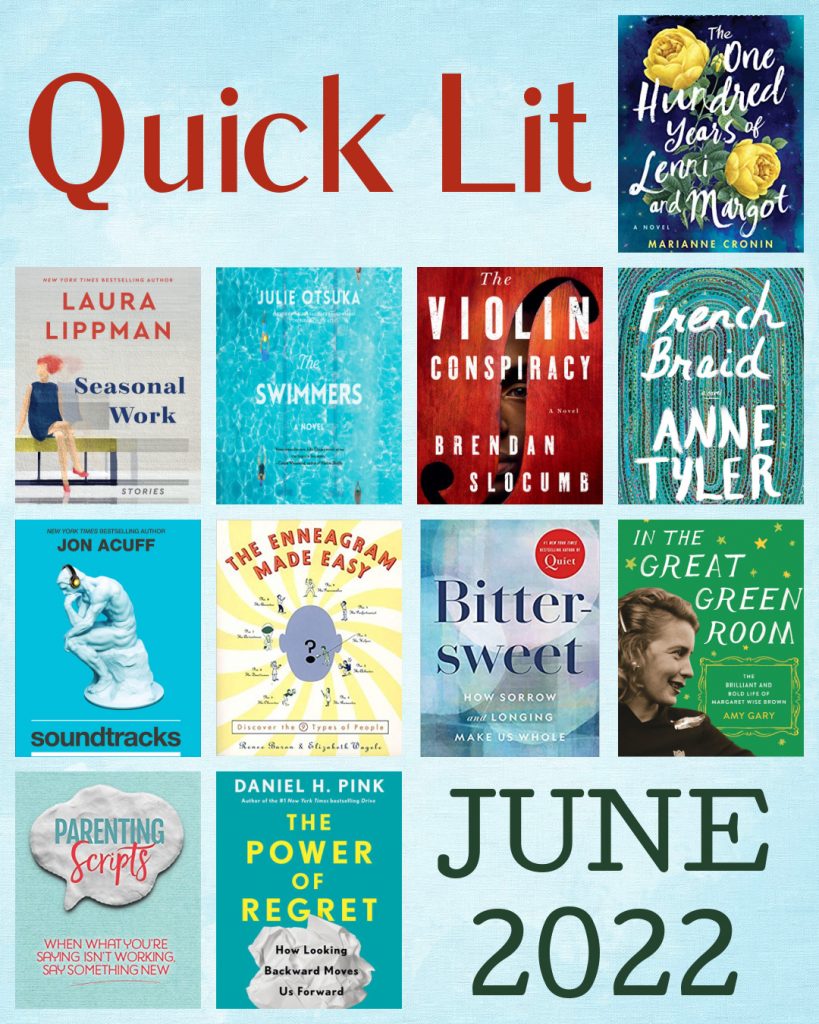
FICTION
The One Hundred Years of Lenni and Margot, by Marianne Cronin: Lenni is a terminally ill seventeen-year-old who is living out her final days in a Glasgow hospital. Her only friends are the lonely hospital chaplain; one especially likable nurse; and a handful of octogenarian patients who live down the hall. Among these senior friends is Margot, an eccentric 83-year-old with a lifetime of stories to share. Margot and Lenni are an unlikely pairing, but they bond over their mutual love of art and story. Together the commit to spending their final days leaving their mark on the world through one hundred illustrations depicting each of their combined one hundred years of life. Through their stories we journey across a century of pain and loss, love and redemption, friendship, survival, and kindness.
I was intrigued by this novel’s unique structure, with the present-day hospital setting interwoven with short stories from the protagonists’ pasts. I enjoyed getting to know Lenni and Margot in this way, but I was most drawn to the present-day drama. I especially loved Lenni’s narrative voice that is cheeky, heartfelt, and wise beyond her years; I wish we were given more of our young narrator, and would have especially liked more page time dedicated to her interactions with Arthur the Priest who is a gem deserving of a whole novel of his own! Their friendship and philosophical discussions were the highlight of the book, outshining the relationships between Lenni and Margot, and between Margot and her various love interests from the past (though Margot’s husband Humphreys is another gem of a character I could have spent more time with).
Because Margot’s stories fill a majority of the book (she obviously has lived more life than Lenni and therefore takes up far more of their combined 100 stories), I felt the novel lost momentum in the recounting of her middle years, and I didn’t love some of those story arcs. Though I struggled to get through the middle third of the novel, I’m glad I pushed through to fully appreciate this celebration of life and friendship. Given the subject matter it’s obviously quite sad, but not at all gruesome or harsh. This is a heartwarming, tearjerker of a book that manages to encompass all of life’s bitter and sweet in one huggable swoop.
My Rating: 4 Stars // Book Format: Kindle

Seasonal Work, by Laura Lipman: This collection from one of our generation’s greatest crime writers features twelve short stories, originally published between 2007 and 2019 (with the exception of the final novella, which is set in COVID times and is original to this anthology). I rarely read short story collections in which every story is a winner, but Laura Lippman has managed to pull off that elusive feat: though I certainly enjoyed some of these stories (The Book Thing, SnowflakeTime, Tricks) more than others (Cougar, Five Fires), not a single one of them disappointed.
The collection, which features a diverse assortment of narrators, plots, and story lengths, is divided into four parts, each with a uniting theme. Part One contains stories featuring Lippman’s beloved PI Tess Monaghan (or, in the case of the third story, Tess’s parents whose mysterious backstory undoubtedly played into the PI’s eventual career choice). Other prominent themes of the various parts are infidelity, cons, vengeance, and coming of age. Not every story is centered around an explicit mystery, but each contains suspenseful or mysterious elements, and every one of them has a mic drop of a conclusion. Desperate housewives, conniving con artists, snooping spouses, and sleuthing reporters—each has a thrill to uncover or deliver; none of their stories is quite as it first seems.
This is not an uplifting story collection. The stories are dark, sinister, and at times very uncomfortable (though the squeamish instances are nicely balanced by several moments of deeply satisfying justice). But there is much to love here for those who appreciate expertly woven stories exuding wry humor, clever pacing, and unflinching insight into the bright and dark sides of humanity.
I highly recommend the audio, which is performed by a twelve separate narrators. Not only did this make for a more dynamic listening experience, it kept the stories from running together as I listened.
My Rating: 4 Stars // Book Format: Audiobook (While following along on Kindle.)
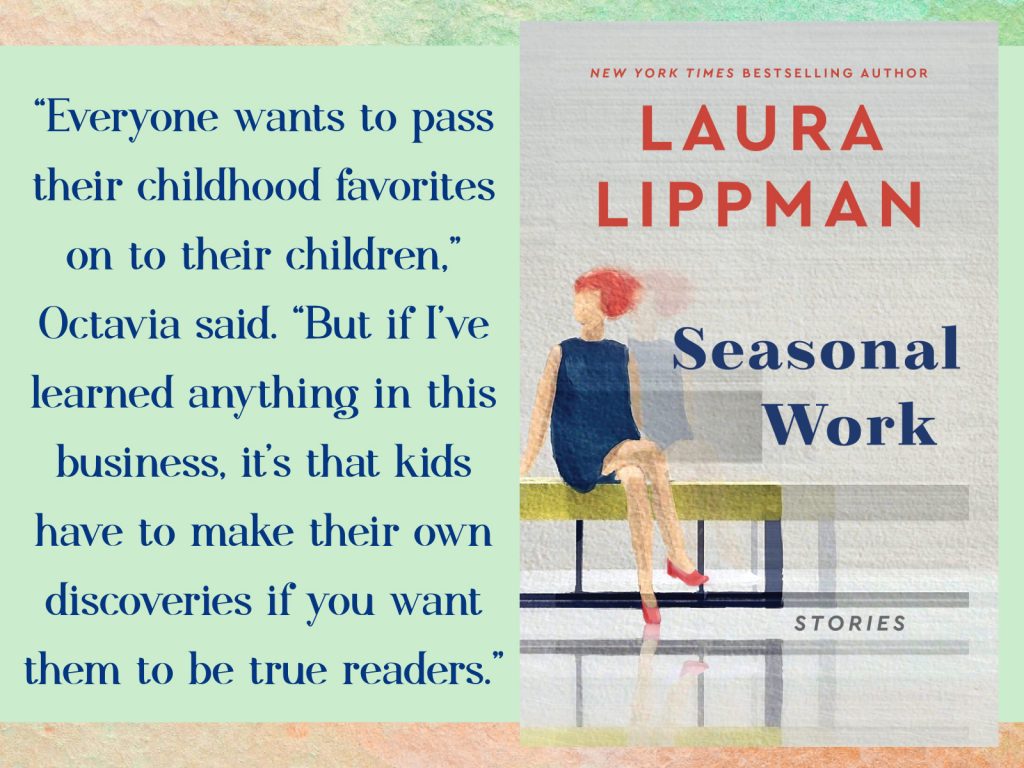
The Swimmers, by Julie Otsuka: We begin with the swimmers, whose story—told in collective first person narration—is one of community and anonymity. The swimmers are unknown to one another in their “other” lives, but when they gather at their community pool they enter a world where their habits and idiosyncrasies are observed and accepted, and their alternate identities all but forgotten as their lane preferences and aquatic rituals take center stage. When an inexplicable crack appears at the bottom of the pool, their place of solace becomes one of uncertainty and fear and eventually abandonment.
The swimmers’ names are not given to us, with the exception of Alice whose story is the focus of the second half of the book. The narrative tense changes as we follow Alice’s slow, painful cognitive decline. We get glimpses into her childhood and the years spent in a Japanese internment camp during the Second World War, and we catch snippets of her years as a young mother and wife. Then we join Alice in her memory care facility, experiencing the confusion and occasional comfort, loneliness, terror, and rhythms of this new world.
I have never read anything like this book. The writing is rhythmic and haunting, at once universal and deeply intimate. Sentences (and the story itself) begin with generalizations and increase in specificity, sketching out ideas before coloring in the details. The format allows Otsuka to provide fascinating social commentary alongside the most personal of experiences, a juxtaposition that works surprisingly well. I felt off-kilter for most of the book and I believe this was the intention, a powerful narrative device that enables the reader to enter into the frightening aspects of dementia and its impact on both the sufferer and those around her. The effect is devastatingly heartbreaking, relentlessly poignant, and entirely unforgettable.
This is HIGHLY literary and won’t be to everyone’s taste, but I loved the ways this book evoked both my intellect and my emotion. The Swimmers is at once witty, tender, and artfully human—a masterpiece I won’t soon forget. I was heartbroken (but not surprised) to learn that much of this book was autobiographical, and enjoyed listening to Otsuka share more in this interview. The mother-daughter story that is the focus of the novel’s final section left me sobbing but was astoundingly beautiful.
My Rating: 5 Stars // Book Format: Print (Because of the repetitive nature of the writing style, I suspect this would be difficult to appreciate on audio.)
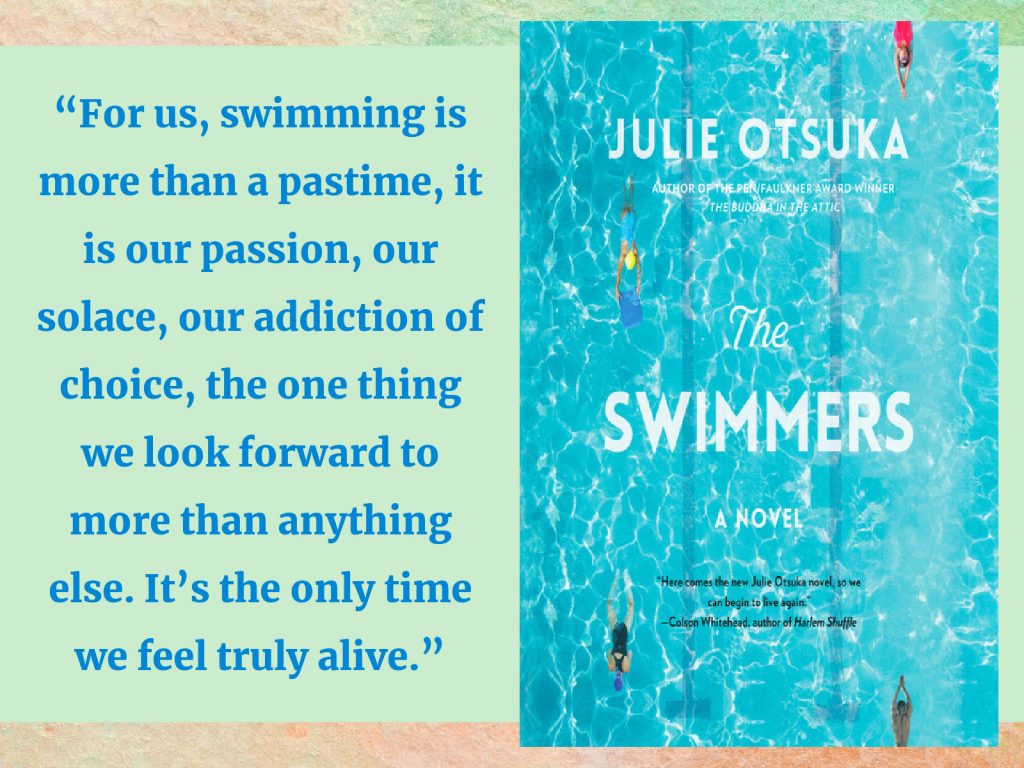
The Violin Conspiracy, by Brendan Slocumb: Ray McMillan is an unlikely classical musician: growing up Black in North Carolina, few people believed in his dream of pursuing a career as a violinist. Only his grandmother can see or appreciate Ray’s raw talent, and when she passes down her own grandfather’s fiddle (the fiddle he played as a slave in the 1800s), Ray is thankful for the gift—then astounded to discover he is in the possession of a priceless Stradivarius. The instrument, combined with Ray’s ambition and musicianship, catapult him to success. Then, on the eve of his competing in the Tchaikovsky Competition (the Olympics of classical music), his violin is stolen and a ransom note is left in its place. Many suspects surface, from his own resentful relatives to the adversarial white family who claim the violin belongs to them; Ray knows the violin is rightfully his, and without it he doubts his own potential for success. As the competition approaches, the violin remains missing and Ray must embark on the challenge of his life without his faithful Stradivarius by his side.
This book is getting a lot of attention and seems to be a hit with reviewers, so I’m sad to go against the crowd with my opinions and say this was mostly a miss for me. Most of the negative opinions I’ve seen mention frustration with the genre: they expected a mystery and were delivered something a little different (there is a mystery component introduced in the beginning and resolved at novel’s end, but a majority of the novel is flashbacks to Ray’s childhood, adolescence, and earlier years as a professional musician; this is more of a coming of age story and exploration of life as a Black musician than anything else). I actually didn’t mind the genre bait-and-switch; I was definitely drawn to the mystery elements and found the ending quite satisfying (even though I predicted it from the start), but I was also interested in the slower, character-driven middle parts of the book and I kind of liked the novel’s nonconformity in both genre and format.
Other negative reviewers pointed to the slowness of the musical descriptions as reasons for their disappointment, and though I agree these parts of the book got tedious at times, I mostly enjoyed these passages (and when they got too technical or flowery, I had no problem skimming them). Music was a big part of my life at one time, and Ray’s performances and practices and passion for music was nostalgic for me and let me tap into something inside myself that has been dormant for some time.
Speaking to my reading experience with The Violin Conspiracy, the struggle in loving this book came down to writing style. The dialogue felt unnatural and the prose seemed amateur and varied quite a bit as the novel progressed; this inconsistency bothered me, and the “rougher” portions were truly painful to get through. I also found the characters formulaic and incredibly unbelievable; they fall into distinct tropes, with Ray coming across as a saint while nearly everyone around him is villainous. I don’t need likable characters in my books, but I do need their unlikability to be at least somewhat believable, and I just couldn’t get there with the cast in this book.
There are many, many instances of explicit and indirect racism throughout the book and these, too, felt over the top. I have no doubt that racism is prevalent in the classical music world and I was open to reading about this, but the author’s extreme depictions of racism came across as so exaggerated that I was disinclined to believe the more subtle (and likely more realistic) racial elements.
I enjoyed hearing the author interviewed on Currently Reading and love the overnight success he has seen with this debut novel. I also really appreciated his Author’s Note and its themes (seen throughout he text as well) of kindness, respectfulness, and dignity in the face of mistreatment. I wish these positive qualities translated into a novel I could appreciate as much as I appreciate the author who penned it.
My Rating 2.75 Stars (Rounded up to 3 Stars on Goodreads) // Book Format: Print
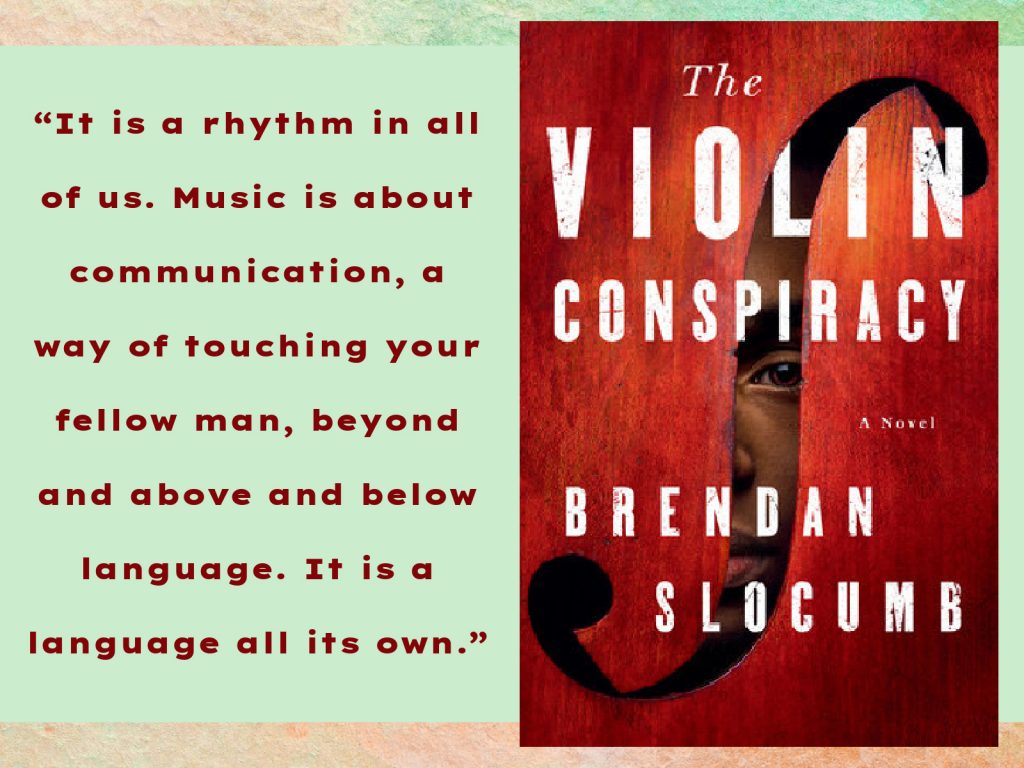
French Braid, by Anne Tyler: French Braid is the decades-long story of one Baltimore family: three generations of Garretts, whose lives and stories and personalities are braided into an intricate portrayal of family. After a brief introductory chapter set in the early 2000s, we travel back to 1959 when Robin and Mercy take their three children (teens Alice and Lily, and seven-year-old David) on their first and final family vacation. The trip is mostly uneventful, but the mundane trip exposes each family member’s true self. And as we familiarize ourselves with this family, we grow more certain that we already know them—because in a way, many of us ARE this family, for all its eccentricities and innocuousness, subliminal conflict, unspoken secrets, and connectedness-but-not-always-closeness. There is no drama, and yet the small interactions ripple beneath the surface, casting waves upon future generations.
In each of the subsequent chapters, set about a decade apart, we check back in with the Garretts. Each snapshot is shared from the perspective of a different family member, so that by the end of the novel (set during the height of the pandemic in 2020), we have been given a complete portrait of how the family members view each other and their circumstances: incorrect assumptions are revealed, as are true motives and previously obscured details, and though this is not a fast-paced story I was utterly riveted, eager to grow in my understanding of all that was or was not happening with each character. I read this mostly on Kindle but was glad to have a print copy from the library on hand, as I needed to do quite a bit of flipping back and forth as pieces of the family tree were filled in. (I actually drew up a visual family tree so that I could keep family members and dates straight—and I found the act of filling in more branches immensely satisfying!)
One of my biggest pet peeves in literature (and in real life, too) is characters who fail to talk to each other, resulting in extended conflict that might have been avoided through some basic transparency. This trope is the crux of the novel, and though it exasperated me at times, it also shed light on why they (we) do this—why we avoid those conversations—and how this is sometimes unavoidable and possibly even kind.
The prose in this novel is deceptively simple and upon first read seems far too straightforward; but as I read on I began to see how each word and each anecdote was meticulously chosen, loaded with metaphor and subliminal messaging. Nearly every page gave me something new to mull over, and I savored each literary morsel. I can imagine this book would be frustrating for some readers: as I mentioned, the plot is subtle and the characters are not especially likable (though, with one exception, they aren’t especially unlikable either—they’re really quite average). But perhaps this is the point: through this ordinary family and their extraordinarily regular lives, we explore poignant, universal themes of closeness, misperception, selfishness, sacrifice, family roles, generational stereotypes, and the ability of outsiders to view us in ways we can’t quite see for ourselves.
I rarely feel a book is too short, but I was unusually sad to see this one come to an end, as I would have loved to view each decade from the perspective of more than one character, or to be given more details of this family beyond the hyper-focused scenes illustrated for us. I must say, though, that I admire Anne Tyler for her restraint: like the trademark paintings of our matriarch Mercy Garrett that offer a zoomed-in view of one portion of a family home, French Braid‘s zeroed-in look at the Garretts reveals the soul of this family, and of all of family life as many of us know it.
I can’t wait to read more from Anne Tyler. Her thoughtful, familiar (though not exactly comforting) work is exactly what I’ve been wanting more of in my reading life.
My Rating: 5 Stars // Book Format: Kindle
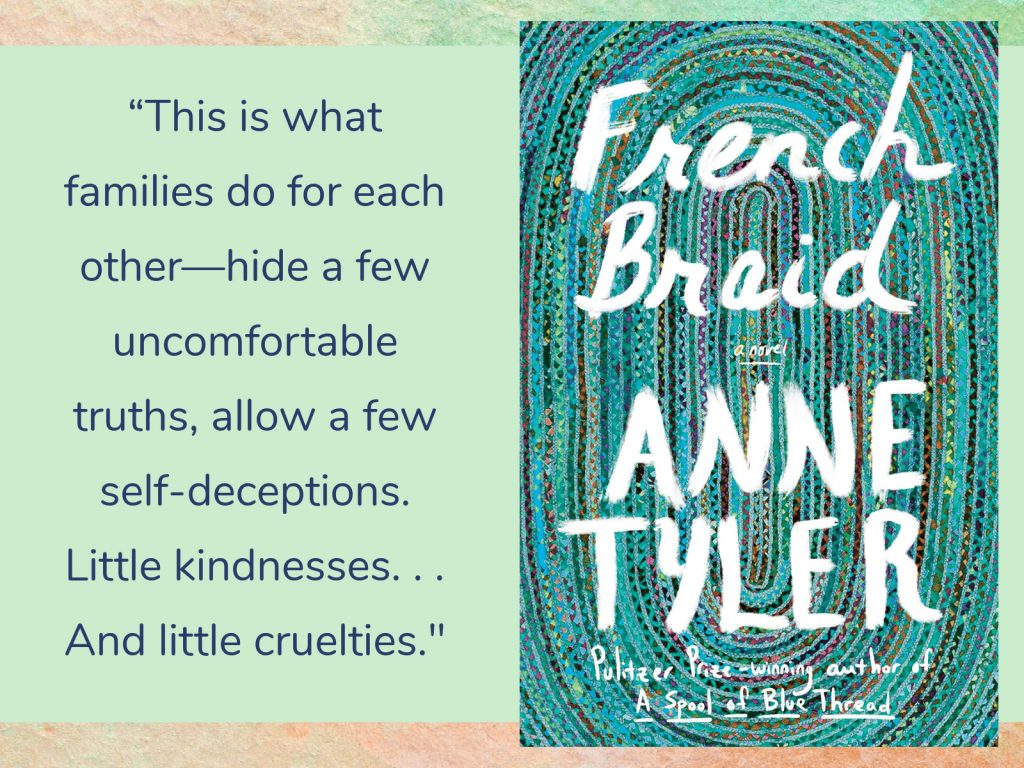
NONFICTION
Soundtracks: The Surprising Solution to Overthinking, by Jon Acuff: Quick, answer this: are you an overthinker? If it took you longer than a few seconds to answer, you were probably overthinking your response. . . which would mean that you, like the vast majority of us, are prone to overthinking. For years, author and self-improvement guru Jon Acuff was a victim of overthinking, with negative soundtracks stealing his productivity, confidence, and joy. That changed when he discovered and developed a superpower: the ability to change his thoughts that were controlling his life. In Soundtracks, Acuff shares the tips and tools he’s learned for conquering overthinking through cultivating better, more productive thought patterns. He shows us how to identify the unhealthy soundtracks we’ve been listening to, turn the dial down on those harmful thought patterns, and replace them with new scripts.
This is such an important subject and I appreciated Acuff’s simple exploration of the problem and his easy-to-adopt solutions. There isn’t a lot of science presented here, but we are given plenty of examples from Acuff’s own life and the lives of contributors to his personal research study, and while I tend to prefer hard data in these types of books, I found the examples accessible and relatable, and also VERY funny. Acuff’s background as a comedian comes through in this book that is as entertaining as it was informative.
Though I would have liked some more depth from this book, there were some great takeaways that will definitely stick with me. I LOVED the tool of weeding out harmful soundtracks by identifying if they are true, helpful, and kind (and I’ve been applying this filter to all of my thought patterns and even my interpersonal communications since reading this—to great success!). The ideas for breaking out of an overthinking loop were also great, as were the suggestions for visible symbols that can be used to draw our attention to new soundtracks. These are all practices I’ve gotten to try since reading and I’m impressed with how well they’ve worked out.
Because of Acuff’s presence in Christian circles I was surprised by how secular this book is. There are obviously some Biblical parallels to the ideas presented here, but in some ways I have a fundamentally different view than Acuff on ideas related to human nature, self-esteem, and even the whole premise of “self help.” (I prefer to spend more time focusing on God and letting Him do a good work in me, instead of attempting to do that work on my own.) It was probably because of these different world views that the tone of the book was off-putting in places. Overall, though, this was a worthwhile read—for the laughs, if nothing else!
My Rating: 4 Stars // Book Format: Audiobook (While following along on Kindle.)
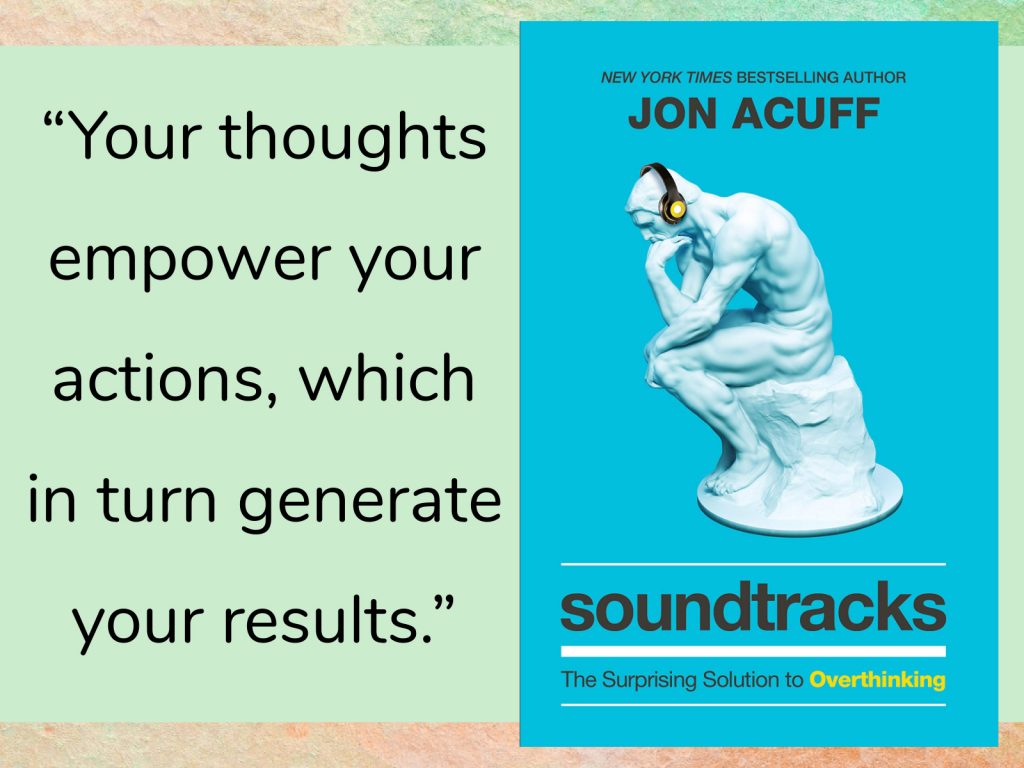
The Enneagram Made Easy, by Renee Baron and Elizabeth Weagle: People regularly ask me where to get started when learning about the Enneagram and I’ve been looking for a quick, straightforward book to recommend. I’ve found it with this book! Originally published in 1994 (LONG before most of us had heard of the Enneagram), the book is a fun and simple guide to Enneagram basics and the nine types.
For each of the nine personality types we are given a personality inventory (for determining if this is your type); tips for getting along with that type; lists of what people like and dislike about their number; explanations of how the types show up in relationships, at work, as parents, and in leisure; descriptions of how the types morph in stress and security (the arrows) and are altered by wings; plus steps for type-specific personal growth. There is a lot of information packed into this brief tome, but it is straightforward and also pretty humorous thanks to cute illustrations and colorful commentary. (I nodded and chuckled my way through the lists of things each type DOESN’T do.)
The one downside to a tutorial like this is that it can’t get into the nuances of each type, but there are plenty of other books for that. This one lives up to its title as EASY and is a fantastic tool for those still looking to determine their type, or those wanting to dig a little deeper into the Enneagram without getting too in the weeds. The Myers-Briggs chapter explaining how the Jungian types align with the Enneagram is unlike anything I’ve seen in other Enneagram resources; not only is this a helpful resource for those who know their Myers-Briggs type and are still determining their Enneagram personality, it was also interesting for me to see which types tend to go together. (I wasn’t too surprised to see that INFJ and Type 1 are a common [but not the most common] pairing.)
As this was written nearly thirty years ago, some of the examples and all of the images are a little dated, but the content itself holds up. I’m so glad to have discovered this gem.
My Rating: 5 Stars // Book Format: Kindle (Purchased in print after reading so I can lend it to friends!)

Bittersweet: How Sorrow and Longing Make Us Whole, by Susan Cain: I love sad music. It evokes in me a sense of emotion and poignancy that upbeat music merely hints at, wooing me with its melancholia and settling my soul into an acceptance of a world that is (and not just a world that I wish for.) I always thought this penchant for sad music was a little strange, something to be ashamed of rather than celebrated. I thought it was odd. But apparently my affinity for subdued tunes is not an anomaly: according to one study, people whose favorite songs are happy listen to them about 175 times on average, but people who favor bittersweet songs listen almost 800 times.
Susan Cain, author of the groundbreaking book Quiet, is also a lover of sad music. In college she began wondering why she found yearning music strangely uplifting; the question led her to research and eventually pen an entire book on the concept of bittersweetness, which she defines as “a tendency to states of longing, poignancy, and sorrow; an acute awareness of passing time; and a curiously piercing joy at the beauty of the world. The bittersweet is also about the recognition that light and dark, birth and death—bitter and sweet—are forever paired.”
In this book that is partly memoir and partly an exploration of psychology, spirituality, art, and neuroscience, Cain asks what bittersweetness is and what it can teach us. She looks at how bittersweetness can transform our longings and pain and sadness into purpose and beauty; how it can help us make peace with our mortality and with grief; and how it becomes a birthplace for connection and wholeness. Cain also examines our history with bittersweetness and our societal aversion to it, looking at why and how we favor happiness (even false positivity) over melancholia, and how an acceptance of a broader range of emotions can benefit us as individuals, corporations, and a human race.
There is SO MUCH going on in this book. The philosophical and spiritual nuggets that tie all the ideas together are golden, and I found myself highlighting, contemplating, talking about, and sharing many of them. Cain is deeply agnostic, and while it was intriguing to read about such a spiritual topic from an author who does not share my faith, it was also somewhat frustrating: on multiple occasions I found myself wanting to jump into the book to share the Gospel with Cain! She touches on spiritual truths and ideas, even quoting Scripture and theologians, and there are so many instances in the book where she posits questions that the Bible can answer! Still, I love that she explores philosophical and spiritual ideas from a place of curiosity and nonjudgment, and I was able to extrapolate many Christian-adjacent takeaways from the book. Perhaps other spiritual seekers may do the same.
As I mentioned, this book covers a lot of ground, and the inclusion of many case studies and individuals’ stories weighed down the more interesting discussions taking place. I loved Cain’s ideas and her writing style, but wish she had narrowed the scope of her research for the sake of a more concise and memorable book. But although the middle dragged some for me, the beginning and ending positively shone. I was fascinated by the discussion of epigenetic and inherited pain; nodded vigorously through the chapter on transcending grief by way of acceptance (which tied in so well with all of Kate Bowler’s work), and was intrigued by the deep dives into music—the subject that started the whole project (especially fun to read, as I was concurrently reading about a fictional musical world in The Violin Conspiracy).
It may seem odd to be comforted by a book about sadness, but I was. I found answers here, and hope. In the same way that Quiet helped me feel seen in my introversion, Bittersweet is helping me make peace with my own bittersweet sensibilities.
My Rating: 4.5 Stars (Rounded down to 4 Stars on Goodreads) // Book Format: Kindle
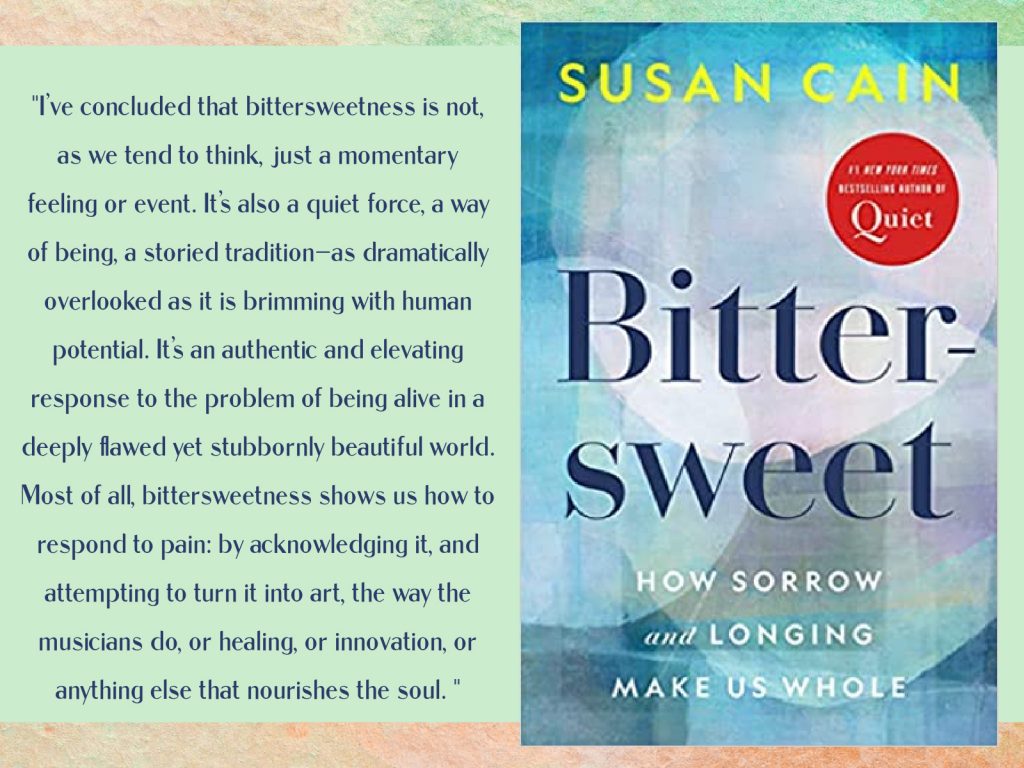
In the Great Great Room: The Brilliant and Bold Life of Margaret Wise Brown, by Amy Gary: Goodnight Moon holds a special place in each of my children’s hearts—such a special place, in fact, that we have worn through a few copies and have every word of every page memorized. My kids come by this love naturally, as my mom tells me it was always a favorite of mine as well. But although the great green room and the telephone and the red balloon may be icons of childhood, their originator is much less known to us. And her story is far more intriguing (and scandalous!) than that emblematic bedtime tale.
In The Great Green Room brings Margaret Wise Brown to life, contrasting the progressive woman with her quaint artistry. Though she is known for her whimsical and imaginative stories, Brown’s short life was marked by unrequited love, troubled love affairs with both men and women, and unfulfilled career aspirations. But a passion for discovery, an unconventional view of the world, and the heart of a dreamer can be seen in both Brown’s life and her work.
This book draws upon Brown’s published and unpublished works, her personal letters, and diaries to offer a complete portrait of Margaret Wise Brown—both the author and the woman. The book is very well researched and offers all the scandalous details of her personal life, as well as insights into her writing process and inspiration. Though the subject matter is solid, the writing didn’t draw me in and it took me weeks to listen to this relatively brief biography from start to finish. I learned a lot, but getting there was somewhat of a struggle.
My Rating: 3.5 Stars (Rounded down to 3 stars on Goodreads.) // Book Format: Audiobook (While following along on Kindle.)
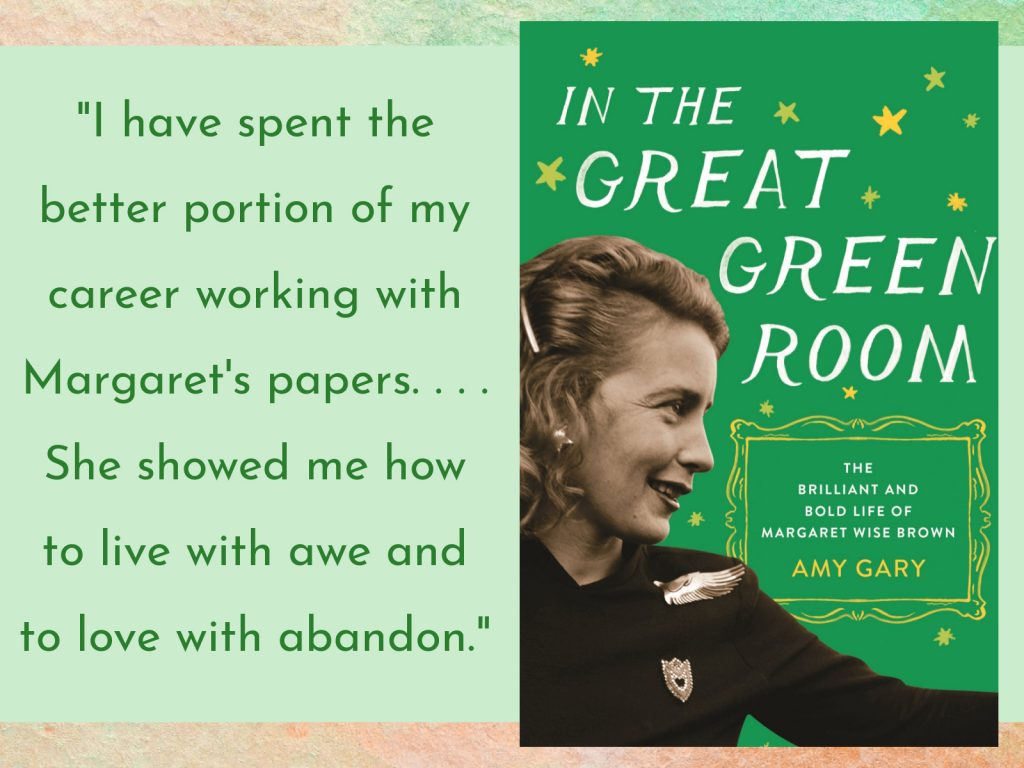
Parenting Scripts: When What You’re Saying Isn’t Working, Say Something New, by Amber Lia and Wende Speake: Some parenting books I read out of curiosity, or preparation for a future challenge, or because I’m in need of a tuneup in the parenting department. And some parenting books I come to out of sheer desperation. Sadly, this was a desperation book: Luke and I have been at a loss with our kids of late and needed a new approach. The subtitle for this book (“When What You’re Saying Isn’t Working”) was a painfully fitting descriptor of our recent parent/child interactions, so when I heard the authors discussing the book on a Focus on the Family broadcast, I couldn’t hit play on this audiobook fast enough.
We all know that what and how we speak to our children is important. Too often, though, we don’t put much thought into our words; we are reactive rather than intentional, and those instinctive words are. . . not great. We default to criticism and bargaining (or worse), and the messages we send are not only harmful to our children but ineffective in changing their actions or their hearts. With some practice and preparation, though, we can replace these poor interactions with scripts that address challenge areas and not only change their behavior but shape their hearts.
Each of the book’s thirty chapters is written to a specific issue parents may struggle with, such as bedtime battles, laziness, tattling, and growing independence. After a brief introduction with scenarios from the authors’ lives, we are are given a succinct parenting script (verbiage around a specific lesson); Scripture to apply to the situation; a prayer; and ideas for adopting the script to your family’s unique needs.
It might seem silly or desperate to turn to a book for exact ways to speak to my children, but I can’t begin to express how helpful this book has been. Nearly every one of the battles we’ve been facing with our kids is addressed here, and the scripts have been a game changer. Scripts for arguing, dissatisfaction, and weekends were especially pertinent, but it is the general approach of the book that I found most helpful. I needed this book’s reminder to invite the Lord into every moment of parenthood and to apply specific Scriptures to our daily interactions. I love the authors’ example of teaching children Scriptures and weaving them into our conversations and discipline—not to weaponize God’s Word, but to allow it to truly shape our kids’ behavior and hearts and minds, and our own. The regular reminders to talk less; to view parenting as a blessing rather than a burden; and to prioritize discipling my kids over my own temporary comfort were convicting but very much appreciated. I really loved the internal scripts (ways to speak to myself that will inform how I speak to my kids) and the marriage scripts to help spouses/coparents get on the same page, and I found the calm, confident, reassuring, truth-filled (but also compassionate) vibe of the book and of the specific scripts and prayers SO empowering.
I listened to this one straight through and I liked consuming it this way as it gave me an overview of a general way to interact with my kids. After listening, I bought this on Kindle so that I can refer back to the specific scripts when issues arise. If you aren’t up for a straight read-through, this could easily be read on a chapter-by-chapter basis. I would say this is best suited for elementary aged kids, but many of the scripts will work well into the teen years and some have been useful with my toddlers, so there really is something here for parents of nearly all kids. My only caveat with this book is that it, like most books of this nature, makes it all seem a little too easy or straightforward; these ideas are great in theory but sometimes hard to implement. But although it may be challenging to bring these scripts into our everyday lives, I can attest to their effectiveness when put to the test.
My Rating: 5 Stars // Book Format: Audiobook (Purchased on Kindle after reading to use for future reference.)
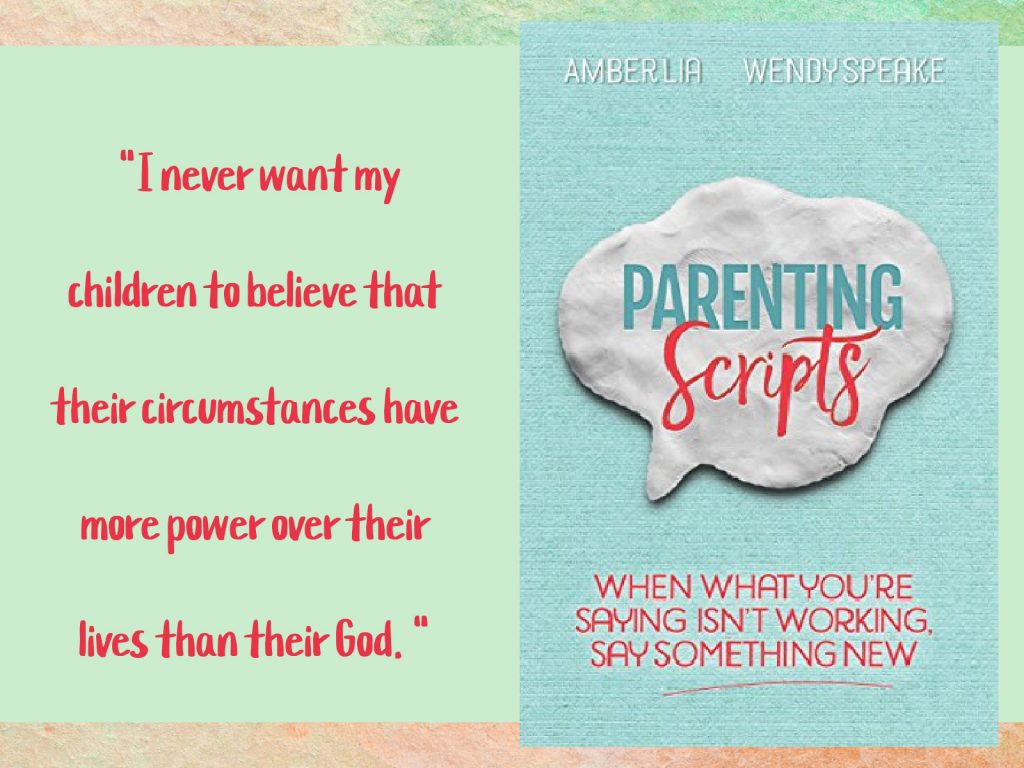
The Power of Regret: How Looking Backward Moves Us Forward, by Daniel S. Pink: It may not be fashionable to admit to our regrets, but we all have them. And Daniel S. Pink wants us to know that that’s okay—helpful, even. In The Power of Regret, Pink draws upon neuroscience, psychology, and the results from his World Regret Study (that spanned 15,000 people over 105 countries) to examine regret and give us a new way of thinking about it. After helping us feel more normal about our regrets (which are part of what make us human) he details the four core types of regret then helps us grapple with our specific regrets—making peace with them, and using what we have learned from our past regrets to make better decisions in the future. Throughout the book we get a look at some of the regrets submitted in the study that touch on everything from missed educational opportunities to poor moral decisions to broken relationships.
I listened to this shortly after reading Susan Cain’s Bittersweet and appreciated how well the two paired, with Cain’s book touching more on the emotion of sadness and Pink exploring the science and practical implications. Some of Pink’s findings were expected (that we all have regrets, and that they can serve to make us better people if we view them appropriately), but there were surprises too, such as the types of regrets that are most prevalent (and the reasons why) and the proven three-step process he offers to overcome regret (which involves, among other tactics, talking to ourselves in the third person and rehashing our regrets with others) and how unsuccessful we tend to be at forecasting the intensity of our future regrets. I was intrigued by Pink’s breakdown of the types of regret, and while it was somewhat painful to see my own regrets in many of these areas, Pink succeeded in his aim of helping me begin to process and redeem those feelings. I’m all about a good redemption story (or route to finding a good redemption story) so the uplifting, forward-thinking vibe of this book was right up my alley.
Pink’s writing style is straightforward and engaging, and though the book is research-heavy, the length felt just right.
My Rating: 4 Stars // Book Format: Audiobook
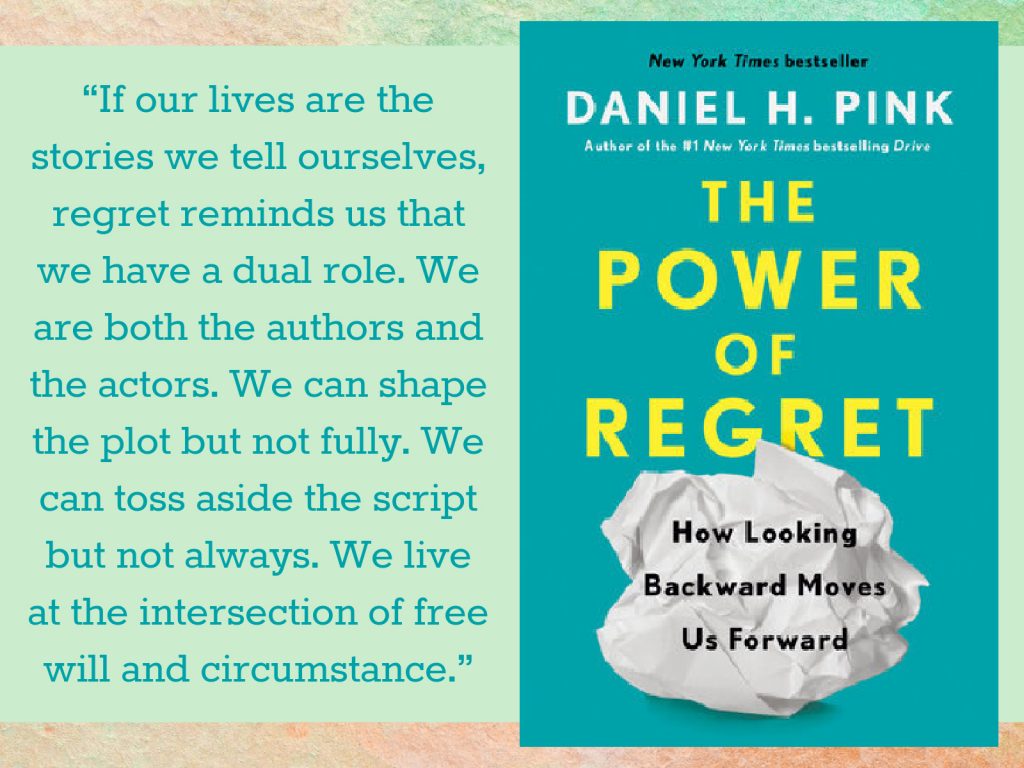
What have you been reading lately? What books are you most eager to read this summer?
I totally agree with you about The Violin Conspiracy.
Parenting Scripts and The Power of Regret both sound interesting! I worked for 17 years with a longitudinal research study that had interviewed the same boys/men repeatedly since they were in elementary school; near the end, in their late thirties, they were asked an open-ended question about what they regretted in their lives so far, and I got to code that data. What really made an impression on me was the number of them who said something along the lines of, “I regret how casually I became a father before I was ready.”–it’s good to recognize that but sad that it’s so common.
I’m glad to know Anne Tyler has another new book! I’ve enjoyed many of hers.
What a fascinating study! And what hard but profound regrets, wow.
I think I need to add French Braid to my much-to-long reading list! Thanks for sharing all these books! Love your format!
I felt the same about Lenni and Margot….too much time spent on Margot’s back story and not enough on the actual friendship!